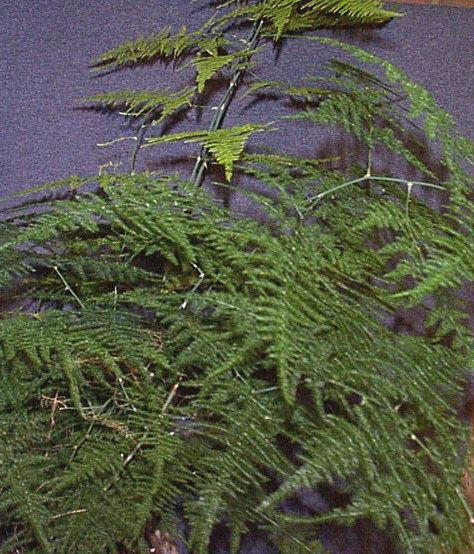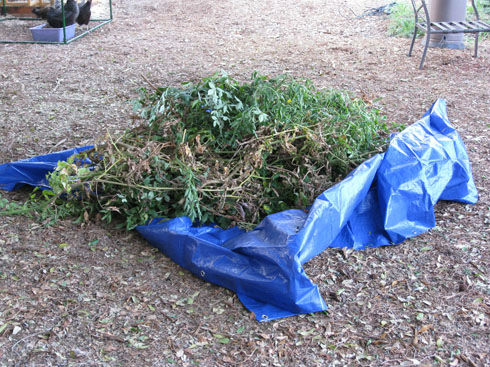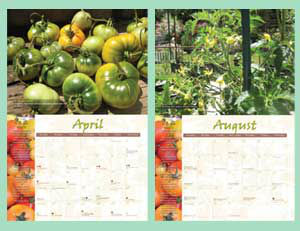A concerned gardenerd writes in, “I found a dying asparagus fern abandoned in the street. It was still alive, but yellowing badly. I suspected either over or under-watering – obviously a challenge to determine which! When I looked more carefully I determined it was root-bound, so I trimmed the roots with a kitchen knife. Any more advice? More water or less? Misting? How about sun or shade? There’s tons of sunlight here in Mexico, but maybe too much?
Also, the soil here is very bad and I can’t find potting soil to purchase. Any advice on supplementing what I dig up from the ground when re-potting plants? I also bought a small rose I want to keep alive, but the soil seems very “un-rich” – dry and sandy. Without time to compost or access to commercial gardening products, is there any way I can supplement the soil?”
Ah, the innocent looking Asparagus Fern. There are several varieties, but most have similar care instructions, but first, a little information. A native of South Africa, the Asparagus Fern isn’t a fern at all, but is related to the kind of asparagus you eat. They both produce flowers and then berries. Beware, the berries cause gastric upset, so make sure you keep them away from little hands and pets.
The two main types of asparagus fern are pictured below:
Foxtail Asparagus Fern

Asparagus Setaceus

I am most familiar with the second one pictured here. With its feathery, flat leaves, this “fern” is a climber that develops sharp thorns along the vine that grab on to neighboring plants and entwine themselves. This is an invasive plant, (in fact, it is listed as a species to avoid in places where rain in plentiful). I have several of these in my back yard and have had difficulty getting them out of the ground. They can strangle a host plant if left to their own devices, so best keep this one in a pot and away from other plants.
Both types can grow in light ranging from shade to full sun, but they prefer bright sunlight that is not direct. Your yellowing issue is most likely due to the plant being in the shade too long, as the leaves are known to yellow when light-deprived. Asparagus ferns are drought tolerant, but do best with regular watering. Fertilize in spring time.
As for amending your soil with limited access to commercial products, try adding spent coffee grounds. They help increase loam in all soil types. Just keep a bag under your sink and dump your coffee grounds each day, if you brew it yourself. Or you can inquire with a local coffee shop to coax their spent grounds out of them at the end of the day. There is a place in Venice Beach, CA called Groundworks where they keep a giant bin in the back of the parking lot. You can show up any time of day with a bag and a trowel and shovel in as much as you can hold. Free for the taking.
If you don’t find coffee grounds, and you are industrious, you can try to locate a brewery in your area and acquire spent hops. They can be used as mulch or for digging in to soil. If you are near the beach, scoop up some seaweed and rinse off the salt, let it dry and shred it. Dig that into your soil as a helpful “kelpful” soil amendment. One other option is worms. If you can find a bait shop nearby, get some red wigglers, loosen your soil and throw them in the mix. If you want to layer some of your spent salad greens on top, they will make quick work of them and start producing castings.
Good luck, and keep us posted on your successes.



You might consider replanting your fern in a pot for awhile to let it recover. Asparagus ferns are typically pretty resilient but it might need some time away from the invaders to regain some footing. If you don’t have space to pot it up, or if you need to replant it in the same space, I would suggest planting it in a basket of hardware cloth or several layers of gopher wire. Mice are tiny, so they can most likely get through gopher wire, but not hardware cloth. It’s made with a 1/2″ mesh that can’t be chewed through.
As for resesitating your fern, don’t put it in direct sunlight, but make sure it gets plenty of light. Re-pot it in some acid-loving soil mix and give it a couple weeks to overcome transplant shock. You can feed it with some kelp emulsion, which is always a good low-level liquid fertilizer and helps plants recover from transplant shock as well.
I hope that helps!
Christy
Found burrowing mice in my foxtail asparagus.they had eaten a lot of the tubers,roots,etc. I losened what I could of the remaining roots @ the bottom of the plant(also bound @ the top but left that alone. Plant looking sickly for several wks. Put new planting soil in, & I’m worried that it won’t survive all the trauma via the mice. Help!
The sooner you can transplant that fern the better. When roots are exposed to air, they don’t do well. Keep in mind that plants can take a couple weeks to get over the shock of transplanting so stick with it and you’ll hopefully see results soon.
So, it turns out, from looking at your photos, that what I’ve got may not actually be an asparagus fern – unless it’s one of the umpteen other varieties you mentioned. But whatever it is, it’s not dead yet…! It’s not THRIVING, exactly, it’s still very yellow in many places, but at least there’s some green. I still haven’t properly transplanted the poor thing – it’s sitting in a Hibachi at the moment – so I’m hoping when I finally find a pot big enough for it (I’ve bought it two pots for it already and both LOOKED big enough, but neither was) it may then begin to thrive. In the meantime, I feed it coffee grinds mixed with a little water/coffee leftovers every morning, and mist it faithfully. I’d say it’s gotten neither better nor worse – though some times of day look greener than others.